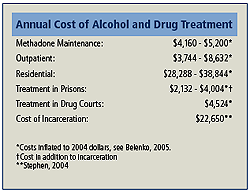
![]()
 Research indicates that an individual’s motivation to reduce substance use improves treatment outcomes; motivation is associated with a decrease in quantity and frequency of alcohol and drug use and an increase in number of days abstinent. Motivation may be internal or external. External motivation, or “coercion,” has been shown to have positive outcomes in the workplace, sports, professional licensure, and the justice system (Nace et al., 2007). Court-mandated treatment has been shown to effectively increase treatment retention rates, increase number of days abstinent, and decrease crime (Nace et al., 2007). While coercion is not always necessary, mandated treatment may provide an opportunity for individuals in the justice system with alcohol and other drug problems to access and benefit from treatment (Whitten, 2006).
Research indicates that an individual’s motivation to reduce substance use improves treatment outcomes; motivation is associated with a decrease in quantity and frequency of alcohol and drug use and an increase in number of days abstinent. Motivation may be internal or external. External motivation, or “coercion,” has been shown to have positive outcomes in the workplace, sports, professional licensure, and the justice system (Nace et al., 2007). Court-mandated treatment has been shown to effectively increase treatment retention rates, increase number of days abstinent, and decrease crime (Nace et al., 2007). While coercion is not always necessary, mandated treatment may provide an opportunity for individuals in the justice system with alcohol and other drug problems to access and benefit from treatment (Whitten, 2006).
HOW TO IDENTIFY EFFECTIVE TREATMENT
- Does the program accept your insurance? If not, will they work with you on a payment plan or find other means of support for you?
- Is the program run by state-accredited, licensed and/or trained professionals?
- Is the facility clean, organized and well-run?
- Does the program encompass the full range of needs of the individual (medical: including infectious diseases; psychological: including co-occurring mental illness; social; vocational; legal; etc.)?
- Does the treatment program also address sexual orientation and physical disabilities as well as provide age, gender and culturally appropriate treatment services?
- Is long-term aftercare support and/or guidance encouraged, provided and maintained?
- Is there ongoing assessment of an individual’s treatment plan to ensure it meets changing needs?
- Does the program employ strategies to engage and keep individuals in longer-term treatment, increasing the likelihood of success?
- Does the program offer counseling (individual or group) and other behavioral therapies to enhance the individual’s ability to function in the family/community?
- Does the program offer medication as part of the treatment regimen, if appropriate?
- Is there ongoing monitoring of possible relapse to help guide patients back to abstinence?
- Are services or referrals offered to family members to ensure they understand addiction and the recovery process to help them support the recovering individual?
Motivation is defined as the individual’s readiness to engage in and complete the various tasks needed to change a specified behavior (Prochaska and DiClemente, 1992). The Stages of Change Model is a research-based clinical guide that explains stages of change and why some populations have a difficult time becoming and remaining abstinent. There are five stages: precontemplation, contemplation, preparation, action, and maintenance. Moving through the Stages of Change successfully requires accomplishing specific tasks at each stage (DiClemente, 2007).
Professionals in the justice system are not expected to use this framework to diagnose individuals; however, the Stages of Change Model (on next page) can assist justice professionals working with individuals with alcohol and other drug problems in their recovery process. Information about treatment readiness should be used to determine whether external pressure is required for treatment retention, and if so how much. Thus, more pressure may be indicated for individuals who are not otherwise treatment ready, but diversion from the justice system or other approaches that employ lesser pressure may be needed in cases when the individual is treatment ready. While individuals in the justice system may not be able to choose from a variety of treatment options, referral to treatment should try to include consideration of individual needs. Effective treatment for substance use problems is not a one-size-fits-all approach.










